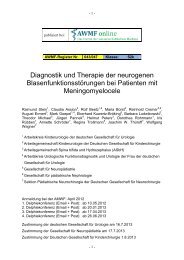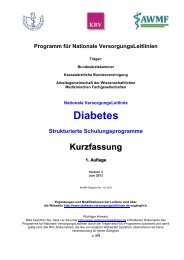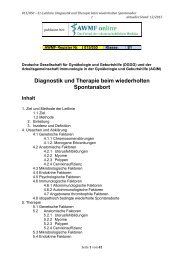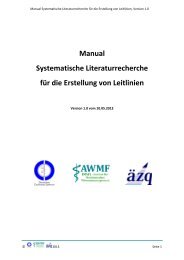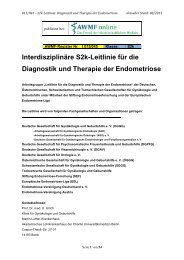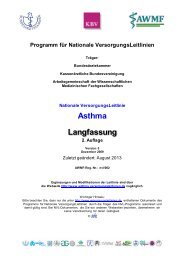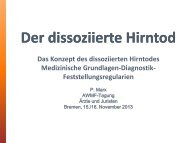Guideline on Treatment of Patients with Severe and Multiple ... - AWMF
Guideline on Treatment of Patients with Severe and Multiple ... - AWMF
Guideline on Treatment of Patients with Severe and Multiple ... - AWMF
Create successful ePaper yourself
Turn your PDF publications into a flip-book with our unique Google optimized e-Paper software.
S3 <str<strong>on</strong>g>Guideline</str<strong>on</strong>g> <strong>on</strong> <strong>Treatment</strong> <strong>of</strong> <strong>Patients</strong> <strong>with</strong> <strong>Severe</strong> <strong>and</strong> <strong>Multiple</strong> Injuries<br />
Explanati<strong>on</strong>:<br />
In the prehospital <strong>and</strong> in-hospital phases, capnometry/capnography must always be used during<br />
endotracheal intubati<strong>on</strong> for m<strong>on</strong>itoring the placement <strong>of</strong> the tube <strong>and</strong> then to reduce incidence <strong>of</strong><br />
dislocati<strong>on</strong> <strong>and</strong> m<strong>on</strong>itor ventilati<strong>on</strong>. Capnography is an essential comp<strong>on</strong>ent here in m<strong>on</strong>itoring<br />
the intubated <strong>and</strong> ventilated patient [74]. Normoventilati<strong>on</strong> should be carried out in<br />
endotracheally intubated <strong>and</strong> anesthetized trauma patients. From emergency room treatment<br />
<strong>on</strong>wards, ventilati<strong>on</strong> must be m<strong>on</strong>itored <strong>and</strong> c<strong>on</strong>trolled by frequent arterial blood gas analyses.<br />
Capnography for m<strong>on</strong>itoring tube placement <strong>and</strong> dislocati<strong>on</strong><br />
The most serious complicati<strong>on</strong> in endotracheal intubati<strong>on</strong> is an unrecognized esophageal<br />
intubati<strong>on</strong>, which can lead to the death <strong>of</strong> the patient. This is why, both prehospital <strong>and</strong> inhospital,<br />
all methods must be applied to recognize esophageal intubati<strong>on</strong> <strong>and</strong> remedy it<br />
immediately.<br />
The percentage <strong>of</strong> esophageal intubati<strong>on</strong>s reported in the literature starts at less than 1% [100,<br />
106] spanning 2% [40], 6% [75], <strong>and</strong> reaching almost 17% [53]. Moreover, a high case fatality<br />
rate was shown as a result <strong>of</strong> tube misplacement in the hypopharynx (33%) or in the esophagus<br />
(56%) [53]. Esophageal intubati<strong>on</strong> is thus not a rare event <strong>and</strong>, particularly in recent years,<br />
various studies have examined this catastrophic complicati<strong>on</strong> <strong>of</strong> endotracheal intubati<strong>on</strong> in<br />
Germany as well. In a prospective observati<strong>on</strong>al study, helicopter emergency physicians trained<br />
in anesthesiology identified an esophageal tube placement in 6 out <strong>of</strong> 84 (7.1%) trauma patients,<br />
who had been intubated by l<strong>and</strong>-based emergency physicians before arrival <strong>of</strong> the helicopter, <strong>and</strong><br />
an endobr<strong>on</strong>chial tube placement in 11 (13.1%) [95]. The case fatality rate <strong>of</strong> esophageally<br />
intubated patients was 80% in this study. In another prospective study <strong>with</strong> 598 patients in a<br />
German emergency physician system, the rate <strong>of</strong> esophageal intubati<strong>on</strong>s by n<strong>on</strong>-medical<br />
pers<strong>on</strong>nel or physicians before arrival <strong>of</strong> the actual emergency physician system was 3.2% [92].<br />
Another prospective observati<strong>on</strong>al study revealed esophageal intubati<strong>on</strong> in 5.1% <strong>of</strong> 58 patients,<br />
who had been intubated by the l<strong>and</strong>-based emergency service or emergency physician before<br />
arrival <strong>of</strong> the helicopter emergency physician trained in anesthesiology [43]. In a study focusing<br />
<strong>on</strong> the admitting emergency room team, esophageal intubati<strong>on</strong> was found in 4 out <strong>of</strong> 375<br />
prehospital intubated <strong>and</strong> ventilated patients (1.1%) [41].<br />
In a prospective observati<strong>on</strong>al study <strong>of</strong> 153 patients, evidence showed that n<strong>on</strong>e <strong>of</strong> the patients<br />
who had been m<strong>on</strong>itored by capnography had an unrecognized misplaced intubati<strong>on</strong>, but 14 out<br />
<strong>of</strong> the 60 patients (23.3%) not m<strong>on</strong>itored by capnography had [83]. Capnography therefore<br />
bel<strong>on</strong>gs in the st<strong>and</strong>ard equipment <strong>of</strong> the anesthesiology workplace <strong>and</strong> has dramatically<br />
increased the safety <strong>of</strong> anesthesia.<br />
In a prospective observati<strong>on</strong>al study <strong>with</strong> 81 patients (n = 58 severe traumatic brain injury [TBI],<br />
n = 6 maxill<strong>of</strong>acial trauma, n = 17 multiple injuries), markedly greater sensitivity <strong>and</strong> specificity<br />
was dem<strong>on</strong>strated by m<strong>on</strong>itoring tube placement by capnography compared to auscultati<strong>on</strong> <strong>on</strong>ly<br />
(sensitivity: 100 versus 94%; specificity: 100 versus 66%, p < 0.01) [44]. These data prove that<br />
capnography must always be used for m<strong>on</strong>itoring tube placement.<br />
Prehospital – Airway management, ventilati<strong>on</strong> <strong>and</strong> emergency anesthesia 29




